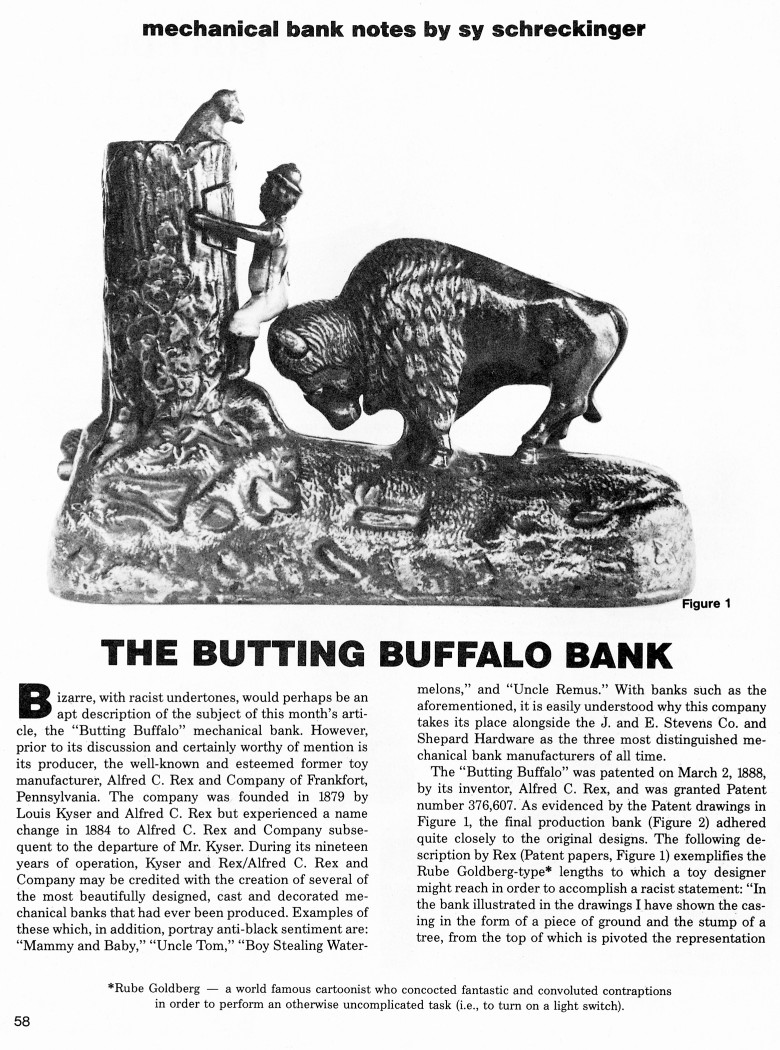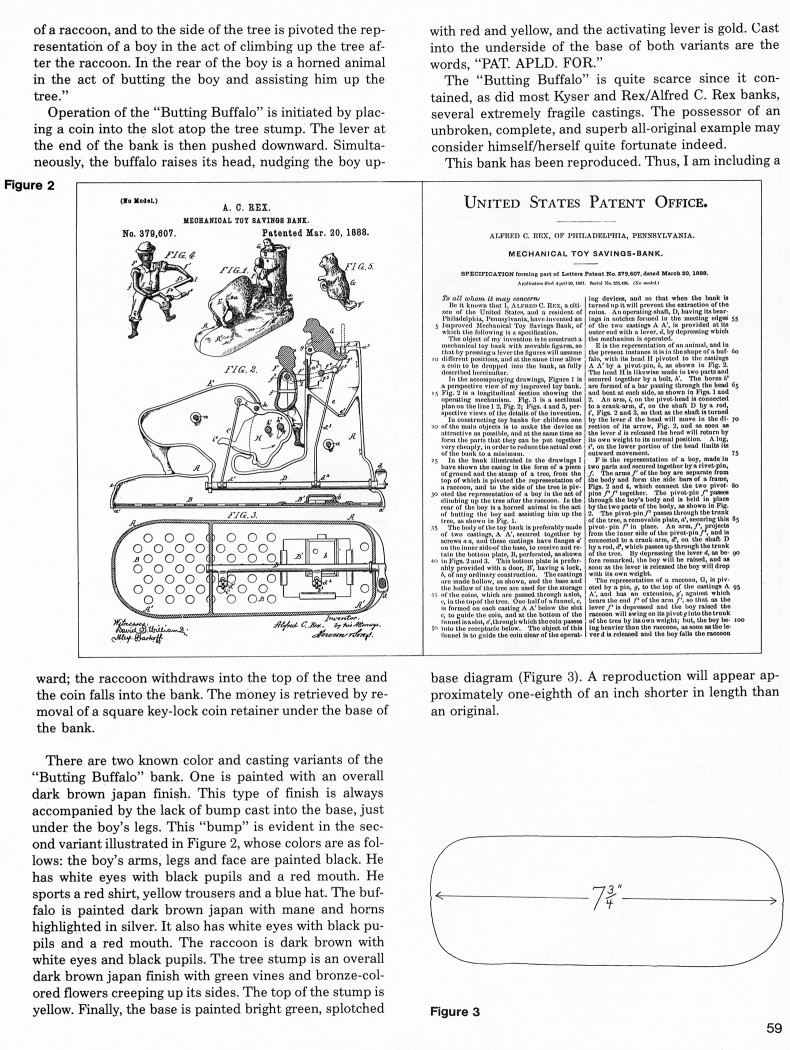|
The Butting Buffalo Bank
by Sy Schreckinger – ANTIQUE TOY WORLD Magazine – September, 1988
Bizarre,
with racist undertones, would perhaps be an
apt description of the subject of this month's article,
the "Butting Buffalo" mechanical bank. However, prior to its
discussion and certainly worthy of mention is its producer, the well-known
and esteemed former toy manufacturer, Alfred C. Rex and Company of
Frankfort, Pennsylvania. The company was
founded in 1879 by Louis Kyser and Alfred C. Rex but experienced a
name change in 1884 to Alfred C. Rex and Company subsequent to the
departure of Mr. Kyser. During its nineteen years of operation, Kyser and
Rex/Alfred C. Rex and Company may be credited with the creation of several
of the most beautifully designed, cast and decorated mechanical banks that had ever been produced. Examples of
these which, in addition, portray
anti-black sentiment are: "Mammy and Baby," "Uncle Tom," "Boy
Stealing Watermelons," and "Uncle Remus." With banks such as the
aforementioned, it is easily understood
why this company takes its place alongside the J. and E. Stevens
Co. and Shepard Hardware as the three most distinguished mechanical bank
manufacturers of all time.
The "Butting Buffalo" was patented on March 2, 1888, by its inventor,
Alfred C. Rex, and was granted Patent number
379,607. As evidenced by the
Patent drawings in Figure 1, the final production bank (Figure 2) adhered
quite closely to the original designs. The following description by Rex
(Patent papers, Figure 1) exemplifies the Rube Goldberg-type* lengths to
which a toy designer might reach in order to accomplish a racist
statement: "In the bank illustrated in the drawings I have shown the
casing in the form of a piece of ground and the stump of a tree, from the
top of which is pivoted the representation of a raccoon, and to the side
of the tree is pivoted the representation of a boy in the act of climbing
up the tree after the raccoon. In the rear of the boy is a horned animal
in the act of butting the boy and assisting him up the tree."
Operation of the "Butting Buffalo" is initiated by placing a coin
into the slot atop the tree stump. The lever at the end of the bank is
then pushed downward. Simultaneously, the buffalo raises its head,
nudging the boy upward; the raccoon withdraws into the top of the tree and
the coin falls into the bank. The money is retrieved by removal of a
square key-lock coin retainer under the base of the bank.
There are two known color and casting variants of the "Butting
Buffalo" bank. One is painted with an overall dark brown japan finish.
This type of finish is always accompanied by the lack of bump cast into
the base, just under the boy's legs. This "bump" is evident in the second
variant illustrated in Figure 2, whose colors are as follows: the boy's
arms, legs and face are painted black. He has white eyes with black pupils
and a red mouth. He sports a red shirt, yellow trousers and a blue hat.
The buffalo is painted dark brown japan with mane and horns highlighted in
silver. It also has white eyes with black pupils and a red mouth. The
raccoon is dark brown with white eyes and black pupils. The tree stump is
an overall dark brown japan finish with green vines and bronze-colored
flowers creeping up its sides. The top of the stump is yellow. Finally,
the base is painted bright green, splotched with red and yellow, and the
activating lever is gold. Cast into the underside of the base of both
variants are the words, "PAT. APLD. FOR."
The "Butting Buffalo" is quite scarce since it contained, as did most
Kyser and Rex/Alfred C. Rex banks, several extremely fragile castings. The
possessor of an unbroken, complete, and superb all-original example may
consider himself/herself quite fortunate indeed.
This bank has been reproduced. Thus, I am including a base diagram
(Figure 3). A reproduction will appear approximately one-eighth of an inch
shorter in length than an original.
*Rube Goldberg — a world famous cartoonist who concocted fantastic
and convoluted contraptions in order to perform an otherwise uncomplicated
task (i.e., to turn on a light switch).
|


